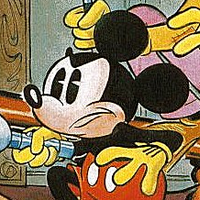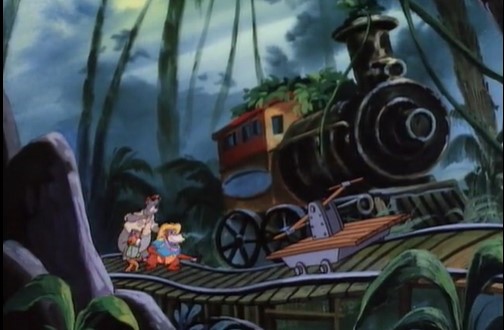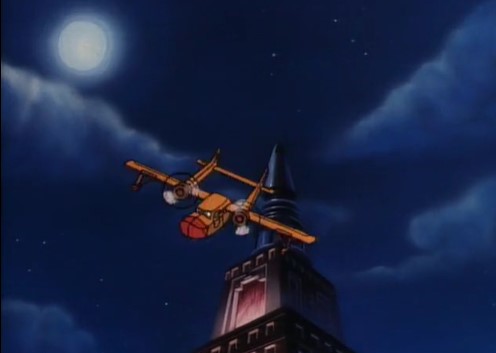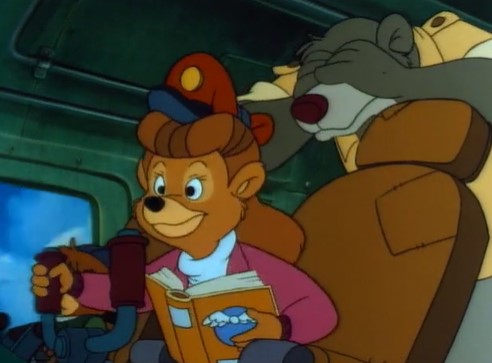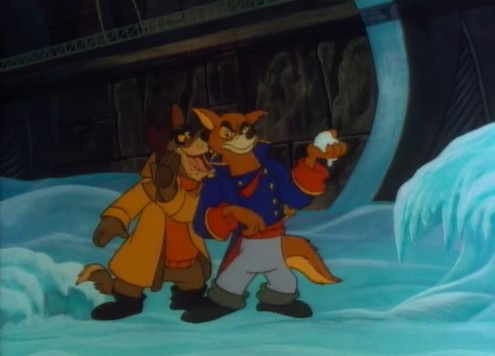Spin It! (A Talespin Retrospective)
Nov 13, 2021 15:57:16 GMT
mousemaestro and donaldistducktoons like this
Post by djnyr on Nov 13, 2021 15:57:16 GMT
I have a tendency to yammer about Talespin in other discussions, so I decided it might not be a bad idea to give the show its own thread (I also recently completed a rewatch of the show, in part prompted by a desire to purge my brain after subjecting myself to the entire run of Ducktales 2017).
One interesting phenomenon I've observed about Talespin is that, while it has a fervent online fanbase, there is fairly little overlap between that fanbase and the wider world of Disney comics. Devotees of the Duck comics, for obvious reasons, tend to pay more attention to Ducktales, Darkwing Duck and (usually only to gape in horror) Quack Pack then they do to Talespin. However, I would argue that, if you ignore the speciation differences between the Duck "universe" and the Talespin world, Talespin is actually closer in spirit to the world of Disney Duck (and Mouse) comics than any other Disney Afternoon show--and is, consequently, the best of the Afternoon's slate of shows. Joe Torcivia has expressed a similar opinion, and although I'm rarely on the same page as him, in this case I entirely concur. Joe and the late Chris Barat are two of the only Disney comics buffs I'm aware of who are/were big fans of Talespin; it was Chris' frequent references to the series in his other blog entries that made me interested in checking out the show for myself (like, I suspect, many other Disney comics devotees, I had tended to assume the series had no points of interest for a Barks or Gottfredson fan and was just a clumsy attempt to cash in on the reissue of The Jungle Book).
Thus, unlike my experience of Ducktales, which I encountered as a kid, I came to Talespin with adult eyes and sharpened critical sense--and was honestly surprised by how much I liked the series. I intend to use this thread (as my schedule allows) to explain just what I liked about it and to engage in a retrospective of the show, with a special eye to demonstrating how it internalized and skillfully utilized so many of the elements of the best Disney funny-animal comic books.
Spin It! Part 1--Origins: Kipling to Disney to Cape Suzette
Talespin has a remote, tangled, and outwardly rather bizarre genesis. Its lead character, Baloo, and one of its primary antagonists, Shere Khan, both hail (pretty much in name only) from a British children's book published almost a hundred years before the show began--i.e., Kipling's Jungle Book.
Rudyard Kipling's original Jungle Book and Second Jungle Book rank among my all-time favorite fantasy/adventure stories, on a level with Tolkien, Lewis, and Richard Adams' Watership Down. I read them after I encountered the Disney feature "adaptation", and the far richer stories significantly diminished my enthusiasm for the movie, which I'd quite enjoyed when I saw it for the first time (its 1990 reissue was one of the first movies I saw in a theater). The movie has something of a cult, since I think it served to imprint a lot of young Boomers on the art of animation, but my own opinion of it was perfectly summed up by a commenter on the late Michael Sporn's animation blog--in brief, it's Walt Disney's equivalent of John Ford's Donavan's Reef or Howard Hawks' El Dorado--a great filmmaker in his twilight years kicking back and amusing himself with hijinks by some colorful characters, but not really paying much attention to plot or structure or emotional depth.
The Disney version of Baloo was a Disney original, essentially created from scratch for the movie; the bear of that name in Kipling's stories was a grave, sober schoolmaster-like figure (Bagheera was actually the reckless and fun-loving one in the books!), nothing like the jovial "jungle bum" of the film. Movie Baloo has remained the best-remembered character from the movie ("Bare Necessities" got an Oscar nomination, after all), and thus it was not all that surprising that he would be recruited when Disney was expanding its TV offers in the late 1980s/early 1990s. Few could have predicted the TV vehicle that he would receive, however.
Jymn Magon (who I will be talking about a lot in this series) was the man primarily responsible for the show that ultimately became Talespin. He had been involved in the creation of both Ducktales and Gummi Bears, and thus when the Disney Studio decided to debut the "Disney Afternoon" programming block, it was to Magon that they turned to come up with a show to run in that block alongside the Ducks, the Gummis, and Chip and Dale Rescue Rangers. Magon's original pitch was for a sitcom called "The B Players", about one-time Disney animation stars and would-be stars trying to win comeback or first-time roles in a Toon version of Hollywood; Baloo was conceived of as one of the leading characters of this show (Horace and Clarabelle would also have been regulars), but there wasn't much interest in the idea.
Magon then dusted off an idea that had surfaced during the developmental phase of Ducktales; evidently, at one point there had been some consideration of making Launchpad the operator of an air freight service and the main character of the series (probably when there was some uncertainty as to how many of the "classic" Duck characters they'd be allowed to use--Mike Peraza has indicated that some negotiations were necessary to get the Nephews on board). Anyway, Magon combined the cargo-pilot idea from the old Ducktales pitch with the character of Baloo from the "B Players" pitch--and a new show emerged from a very eclectic matrix.
Sources:
Magon talks about the series' genesis in these posts on the old Talespin Animation Source website:
www.animationsource.org/talespin/en/custom_questions/Why-The-Jungle-Book/157.html&nump=1338
www.animationsource.org/talespin/en/custom_questions/The-B-Players-.../156.html&nump=1338
Peraza's post about the early days of Ducktales, referencing the negotiations for use of the classic characters, is here:
michaelperaza.blogspot.com/2010/08/days-of-ducktales-part-1.html
Spin It! Part 2--The World of Cape Suzette
The universe of the new show was eclectic too; its time period was never specified within the series itself, but it was definitely a pastiche of the late 1930s. As Magon stated in a 1990 promotional piece for Buena Vista Television:
"Well, the time and locale of the show both suggest those old movie serials of the thirties. It was a very exciting time to be a kid, when things were still exotic and mysterious. So we wanted to do a 'Terry and the Pirates' kind of show. Also, what appealed to us about that era was the scale of things. Today, technology has miniaturized everything, which isn't visually exciting. But in that era, anything powerful was really big, which is great for a cartoon show. We've also got the atmosphere of that time with the nightclubs, art deco, and old cars. It gives the show an exciting feel."
To Magon's comments, I would add that not only did the show's period setting evoke Terry and the Pirates (the greatest adventure comic strip of the 1930s and 1940s), but it also called to mind the 1930s Gottfredson Mickey Mouse strips, particularly the aviation-centered continuities like "The Mail Pilot", "Island in the Sky" and "The Pirate Submarine," where flying is inherently adventurous and exciting, not just another means of mass transportation. One of the many strengths of Talespin was the fact that it played the "romance of aviation" theme entirely straight; flying was something special on the show, and something that the lead characters (Baloo and Kit Cloudkicker) were truly passionate about. That passion was taken seriously; there were no wink-wink benefit-of-hindsight jokes about how clunky the planes of that period were and how much better modern aviation technology is.
In short, the series made a genuine effort to enter into the spirit of the period it was depicting, not merely copy the period's trappings. To quote Magon again, in another quote from the same 1990 promotional piece, Magon remarked that "Today, kids are exposed to so much. They're a little jaded. So the challenge was taking the excitement of an older time without making it look old fashioned." I will carefully try to avoid bashing New Ducktales too much in this series, but I can't help but remark that this attitude of trying to awaken a sense of wonder and excitement, instead of simply trying to play down to modern kids' (presumed) jadedness and cynicism, as New Ducktales did, is a vastly preferable approach to animated storytelling (or any kind of storytelling).
Returning to the Mickey Mouse comparisons, another way in which Talespin echoed the early Mickey strips was in the diversity of species among its cast; like the goats, monkeys, pigs, rats, cats, geese, hens, horse, cows and wide varieties of dog breeds that peopled earlier Gottfredson stories, the characters on Talespin weren't just humans with little black noses, but rather animals that had been mostly but not entirely anthropomorphised; their wardrobes were rarely complete, like those of the early Mickey characters (more than half of them didn't wear pants, and hardly any of them wore shoes), and every now and then there'd be a gag to remind one of their non-anthropomorphic counterparts (like Louie the orangutan using his feet to shake hands). Unlike the largely barnyard cast of the Mickey strips, however, most of the Talespin cast were wild critters--bears, big cats, apes, hippos, wolves, wild boars, foxes, and the like. In this regard, it was also more than a little reminiscent of the 1970s Disney Robin Hood animated film.
Talespin's zoofull of characters leant enormous visual variety and appeal to the series, making even minor guest characters entertainingly idiosyncratic to look at. The generally perceived "personalities" of the various species also allowed for effective visual shorthand in establishing characterizations (tigers as ruthless capitalists, monkeys as fun-loving partiers, bulldogs as army generals, and so forth) as well as humor derived from playing against the usual expectations for the species (belligerent military poodles, porcine sanitation inspectors, etc.).
In keeping with the jungle origins of the leading characters, "Cape Suzette," the massive Art Deco city in which the series was based, was clearly tropical; its location was never directly tied to any place in the real world. It was reminiscent at times of Sydney or Hong Kong--a modern city within flying distance of more exotic and remote locales and in the same hemisphere as a Soviet Union equivalent ("Thembria"), but it was also obviously American in a cultural sense; much like Barks' Duckburg, it was both a part of America but yet at the same time its own thing (the Thembrians would also refer to Baloo and company as "Cape Suzette swine" as if the city was an independent nation, much as Barks' Duckburg has its own consuls and embassies). The reference in Talespin's pilot episode to the "Sox" (i.e., the Red Sox, then on a seventy-year championship-free streak) as having won the Series felt like a definite acknowledgment that the show was set in our world but not quite in the world as we know it.
Sources:
Jymn Magon's own blog provided the full text of the Buena Vista Television promotional piece for the Disney Afternoon quoted above:
finetooning.wordpress.com/2015/10/21/disney-afternews/
Next Up: The Characters
One interesting phenomenon I've observed about Talespin is that, while it has a fervent online fanbase, there is fairly little overlap between that fanbase and the wider world of Disney comics. Devotees of the Duck comics, for obvious reasons, tend to pay more attention to Ducktales, Darkwing Duck and (usually only to gape in horror) Quack Pack then they do to Talespin. However, I would argue that, if you ignore the speciation differences between the Duck "universe" and the Talespin world, Talespin is actually closer in spirit to the world of Disney Duck (and Mouse) comics than any other Disney Afternoon show--and is, consequently, the best of the Afternoon's slate of shows. Joe Torcivia has expressed a similar opinion, and although I'm rarely on the same page as him, in this case I entirely concur. Joe and the late Chris Barat are two of the only Disney comics buffs I'm aware of who are/were big fans of Talespin; it was Chris' frequent references to the series in his other blog entries that made me interested in checking out the show for myself (like, I suspect, many other Disney comics devotees, I had tended to assume the series had no points of interest for a Barks or Gottfredson fan and was just a clumsy attempt to cash in on the reissue of The Jungle Book).
Thus, unlike my experience of Ducktales, which I encountered as a kid, I came to Talespin with adult eyes and sharpened critical sense--and was honestly surprised by how much I liked the series. I intend to use this thread (as my schedule allows) to explain just what I liked about it and to engage in a retrospective of the show, with a special eye to demonstrating how it internalized and skillfully utilized so many of the elements of the best Disney funny-animal comic books.
Spin It! Part 1--Origins: Kipling to Disney to Cape Suzette
Talespin has a remote, tangled, and outwardly rather bizarre genesis. Its lead character, Baloo, and one of its primary antagonists, Shere Khan, both hail (pretty much in name only) from a British children's book published almost a hundred years before the show began--i.e., Kipling's Jungle Book.
Rudyard Kipling's original Jungle Book and Second Jungle Book rank among my all-time favorite fantasy/adventure stories, on a level with Tolkien, Lewis, and Richard Adams' Watership Down. I read them after I encountered the Disney feature "adaptation", and the far richer stories significantly diminished my enthusiasm for the movie, which I'd quite enjoyed when I saw it for the first time (its 1990 reissue was one of the first movies I saw in a theater). The movie has something of a cult, since I think it served to imprint a lot of young Boomers on the art of animation, but my own opinion of it was perfectly summed up by a commenter on the late Michael Sporn's animation blog--in brief, it's Walt Disney's equivalent of John Ford's Donavan's Reef or Howard Hawks' El Dorado--a great filmmaker in his twilight years kicking back and amusing himself with hijinks by some colorful characters, but not really paying much attention to plot or structure or emotional depth.
The Disney version of Baloo was a Disney original, essentially created from scratch for the movie; the bear of that name in Kipling's stories was a grave, sober schoolmaster-like figure (Bagheera was actually the reckless and fun-loving one in the books!), nothing like the jovial "jungle bum" of the film. Movie Baloo has remained the best-remembered character from the movie ("Bare Necessities" got an Oscar nomination, after all), and thus it was not all that surprising that he would be recruited when Disney was expanding its TV offers in the late 1980s/early 1990s. Few could have predicted the TV vehicle that he would receive, however.
Jymn Magon (who I will be talking about a lot in this series) was the man primarily responsible for the show that ultimately became Talespin. He had been involved in the creation of both Ducktales and Gummi Bears, and thus when the Disney Studio decided to debut the "Disney Afternoon" programming block, it was to Magon that they turned to come up with a show to run in that block alongside the Ducks, the Gummis, and Chip and Dale Rescue Rangers. Magon's original pitch was for a sitcom called "The B Players", about one-time Disney animation stars and would-be stars trying to win comeback or first-time roles in a Toon version of Hollywood; Baloo was conceived of as one of the leading characters of this show (Horace and Clarabelle would also have been regulars), but there wasn't much interest in the idea.
Magon then dusted off an idea that had surfaced during the developmental phase of Ducktales; evidently, at one point there had been some consideration of making Launchpad the operator of an air freight service and the main character of the series (probably when there was some uncertainty as to how many of the "classic" Duck characters they'd be allowed to use--Mike Peraza has indicated that some negotiations were necessary to get the Nephews on board). Anyway, Magon combined the cargo-pilot idea from the old Ducktales pitch with the character of Baloo from the "B Players" pitch--and a new show emerged from a very eclectic matrix.
Sources:
Magon talks about the series' genesis in these posts on the old Talespin Animation Source website:
www.animationsource.org/talespin/en/custom_questions/Why-The-Jungle-Book/157.html&nump=1338
www.animationsource.org/talespin/en/custom_questions/The-B-Players-.../156.html&nump=1338
Peraza's post about the early days of Ducktales, referencing the negotiations for use of the classic characters, is here:
michaelperaza.blogspot.com/2010/08/days-of-ducktales-part-1.html
Spin It! Part 2--The World of Cape Suzette
The universe of the new show was eclectic too; its time period was never specified within the series itself, but it was definitely a pastiche of the late 1930s. As Magon stated in a 1990 promotional piece for Buena Vista Television:
"Well, the time and locale of the show both suggest those old movie serials of the thirties. It was a very exciting time to be a kid, when things were still exotic and mysterious. So we wanted to do a 'Terry and the Pirates' kind of show. Also, what appealed to us about that era was the scale of things. Today, technology has miniaturized everything, which isn't visually exciting. But in that era, anything powerful was really big, which is great for a cartoon show. We've also got the atmosphere of that time with the nightclubs, art deco, and old cars. It gives the show an exciting feel."
To Magon's comments, I would add that not only did the show's period setting evoke Terry and the Pirates (the greatest adventure comic strip of the 1930s and 1940s), but it also called to mind the 1930s Gottfredson Mickey Mouse strips, particularly the aviation-centered continuities like "The Mail Pilot", "Island in the Sky" and "The Pirate Submarine," where flying is inherently adventurous and exciting, not just another means of mass transportation. One of the many strengths of Talespin was the fact that it played the "romance of aviation" theme entirely straight; flying was something special on the show, and something that the lead characters (Baloo and Kit Cloudkicker) were truly passionate about. That passion was taken seriously; there were no wink-wink benefit-of-hindsight jokes about how clunky the planes of that period were and how much better modern aviation technology is.
In short, the series made a genuine effort to enter into the spirit of the period it was depicting, not merely copy the period's trappings. To quote Magon again, in another quote from the same 1990 promotional piece, Magon remarked that "Today, kids are exposed to so much. They're a little jaded. So the challenge was taking the excitement of an older time without making it look old fashioned." I will carefully try to avoid bashing New Ducktales too much in this series, but I can't help but remark that this attitude of trying to awaken a sense of wonder and excitement, instead of simply trying to play down to modern kids' (presumed) jadedness and cynicism, as New Ducktales did, is a vastly preferable approach to animated storytelling (or any kind of storytelling).
Returning to the Mickey Mouse comparisons, another way in which Talespin echoed the early Mickey strips was in the diversity of species among its cast; like the goats, monkeys, pigs, rats, cats, geese, hens, horse, cows and wide varieties of dog breeds that peopled earlier Gottfredson stories, the characters on Talespin weren't just humans with little black noses, but rather animals that had been mostly but not entirely anthropomorphised; their wardrobes were rarely complete, like those of the early Mickey characters (more than half of them didn't wear pants, and hardly any of them wore shoes), and every now and then there'd be a gag to remind one of their non-anthropomorphic counterparts (like Louie the orangutan using his feet to shake hands). Unlike the largely barnyard cast of the Mickey strips, however, most of the Talespin cast were wild critters--bears, big cats, apes, hippos, wolves, wild boars, foxes, and the like. In this regard, it was also more than a little reminiscent of the 1970s Disney Robin Hood animated film.
Talespin's zoofull of characters leant enormous visual variety and appeal to the series, making even minor guest characters entertainingly idiosyncratic to look at. The generally perceived "personalities" of the various species also allowed for effective visual shorthand in establishing characterizations (tigers as ruthless capitalists, monkeys as fun-loving partiers, bulldogs as army generals, and so forth) as well as humor derived from playing against the usual expectations for the species (belligerent military poodles, porcine sanitation inspectors, etc.).
In keeping with the jungle origins of the leading characters, "Cape Suzette," the massive Art Deco city in which the series was based, was clearly tropical; its location was never directly tied to any place in the real world. It was reminiscent at times of Sydney or Hong Kong--a modern city within flying distance of more exotic and remote locales and in the same hemisphere as a Soviet Union equivalent ("Thembria"), but it was also obviously American in a cultural sense; much like Barks' Duckburg, it was both a part of America but yet at the same time its own thing (the Thembrians would also refer to Baloo and company as "Cape Suzette swine" as if the city was an independent nation, much as Barks' Duckburg has its own consuls and embassies). The reference in Talespin's pilot episode to the "Sox" (i.e., the Red Sox, then on a seventy-year championship-free streak) as having won the Series felt like a definite acknowledgment that the show was set in our world but not quite in the world as we know it.
Sources:
Jymn Magon's own blog provided the full text of the Buena Vista Television promotional piece for the Disney Afternoon quoted above:
finetooning.wordpress.com/2015/10/21/disney-afternews/
Next Up: The Characters

